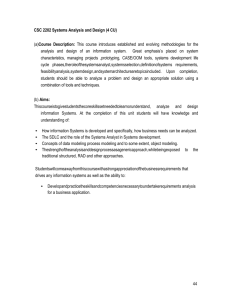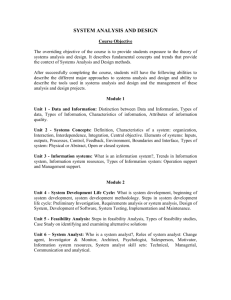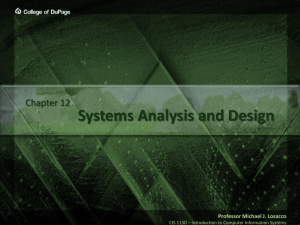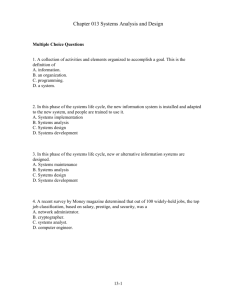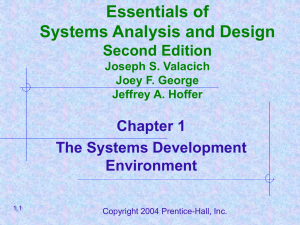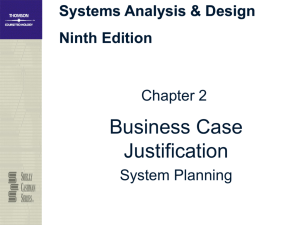Terms and QuesAnswers Chap0013
advertisement
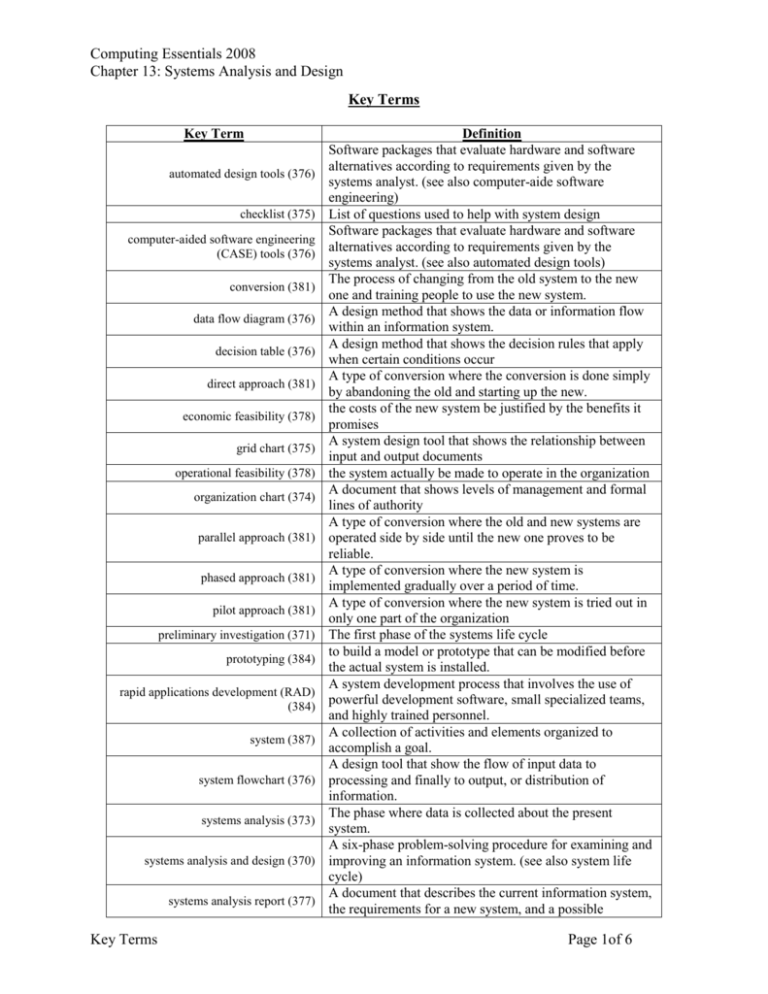
Computing Essentials 2008 Chapter 13: Systems Analysis and Design Key Terms Key Term automated design tools (376) checklist (375) computer-aided software engineering (CASE) tools (376) conversion (381) data flow diagram (376) decision table (376) direct approach (381) economic feasibility (378) grid chart (375) operational feasibility (378) organization chart (374) parallel approach (381) phased approach (381) pilot approach (381) preliminary investigation (371) prototyping (384) rapid applications development (RAD) (384) system (387) system flowchart (376) systems analysis (373) systems analysis and design (370) systems analysis report (377) Key Terms Definition Software packages that evaluate hardware and software alternatives according to requirements given by the systems analyst. (see also computer-aide software engineering) List of questions used to help with system design Software packages that evaluate hardware and software alternatives according to requirements given by the systems analyst. (see also automated design tools) The process of changing from the old system to the new one and training people to use the new system. A design method that shows the data or information flow within an information system. A design method that shows the decision rules that apply when certain conditions occur A type of conversion where the conversion is done simply by abandoning the old and starting up the new. the costs of the new system be justified by the benefits it promises A system design tool that shows the relationship between input and output documents the system actually be made to operate in the organization A document that shows levels of management and formal lines of authority A type of conversion where the old and new systems are operated side by side until the new one proves to be reliable. A type of conversion where the new system is implemented gradually over a period of time. A type of conversion where the new system is tried out in only one part of the organization The first phase of the systems life cycle to build a model or prototype that can be modified before the actual system is installed. A system development process that involves the use of powerful development software, small specialized teams, and highly trained personnel. A collection of activities and elements organized to accomplish a goal. A design tool that show the flow of input data to processing and finally to output, or distribution of information. The phase where data is collected about the present system. A six-phase problem-solving procedure for examining and improving an information system. (see also system life cycle) A document that describes the current information system, the requirements for a new system, and a possible Page 1of 6 Computing Essentials 2008 Chapter 13: Systems Analysis and Design systems analyst (370, 385) systems audit (383) systems design (378) systems design report (379) systems development (379) systems implementation (381) systems life cycle (370) systems maintenance (383) technical feasibility (378) top-down analysis method (375) Key Terms development schedule. A person who plans and designsnew systems or reorganize a company’s computer resources to best utilize them A process where the system’s performance is compared to the original design specifications. The third phase of the system development life cycle A document prepared for higher management and describes the alternative designs. The fourth phase of the system development life cycle. The fifth phase of the system development life cycle A six-phase problem-solving procedure for examining and improving an information system. (see also system analysis and design) The sixth phase of the system development life cycle Making sure reliable hardware, software, and training are available to make the system work A method used to identify the top-level components of a complex system. Page 2of 6 Computing Essentials 2008 Chapter 13: Systems Analysis and Design Crossword Puzzle Answers: Across Num. 3 8 9 10 12 14 15 Clue Systems implementation Collection of activities and elements organized to accomplish a goal. Build a model that can be modified before the system is installed. Automated design tool. Approach where new system is tried in only one part of an organization. Shows levels of management and formal lines of authority. List of questions. Answer Conversion System Prototyping CASE Pilot Organization chart Checklist Down Num. Clue 1 2 4 1st step in the design phase. Study an organization’s systems. System’s performance is compared to the original specifications. Approach where new system is implemented slowly over time. Conversion done by abandoning old system and starting the new. Diagram that shows the information flow within an organization. Shows the relationship between input and output documents. Old and new systems are operated side by side. The most commonly overlooked activity in the implementation phase. 5 6 7 11 12 13 Num Multiple Choice Answers Matching Answers 1 2 3 4 5 6 7 8 9 10 A D A C D D A D A C G H F D C A B I J E Answers to End of Chapter materials Answer Feasibility Systems analysis System audit Phased Direct approach Data flow Grid chart Parallel Training Page 3 of 6 Computing Essentials 2008 Chapter 13: Systems Analysis and Design Open Ended Questions: 1. What is a system? What are the six phases of the systems life cycle? Why do corporations undergo this process? A system is a collection of activities and elements organized to accomplish a goal. An information system is a collection of hardware, software, people, procedures, and data. It provides information essential to running an organization. The phases are: Preliminary investigation: The information problems or needs are identified. Systems analysis: The present system is studied in depth. New requirements are specified. Systems design: A new or alternative information system is designed. Systems development: New hardware and software are acquired, developed, and tested. Systems implementation: The new information system is installed and adapted to the new system, and people are trained to use it. Systems maintenance: In this ongoing phase, the system is periodically evaluated and updated as needed. Systems analysis and design is a six-phase problem-solving procedure for examining and improving an information system. 2. What are the tools used in the analysis phase? What is top-down analysis? How is it used? Tools used in the analysis phase are: Checklists – a list of questions that are helpful in guiding the systems analyst and end user through key issues for the present system Top-down analysis method - used to identify the top-level components of a complex system, then broken down into smaller and smaller components. Grid charts - shows the relationship between input and output documents. Decision tables - shows the decision rules that apply when certain conditions occur. System flowcharts - show the flow of input data to processing and finally to output, or distribution of information. Data flow diagrams - The data is traced from its origin through processing, storage, and output. Automated design tools - software packages that evaluate hardware and software alternatives according to requirements given by the systems analyst 3. Describe each type of system conversion. Which is the most commonly used? a. Direct approach - the conversion is done simply by abandoning the old and starting up the new. b. Parallel approach (392) - old and new systems are operated side by side until the new one proves to be reliable. c. Pilot approach - the new system is tried out in only one part of the organization d. Phased approach - the new system is implemented gradually over a period of time. The pilot and phased approaches are the most preferred. Answers to End of Chapter materials Page 4 of 6 Computing Essentials 2008 Chapter 13: Systems Analysis and Design 4. What is systems maintenance? When does it occur? a. Systems maintenance is the final phase. It consists of a systems audit followed by periodic evaluation. 5. Explain prototyping and RAD. When might they be used by corporations? Alternative approaches that require much less time a. Prototyping i. means to build a model or prototype that can be modified before the actual system is installed ii. Users would try it out and provide feedback to the systems analyst. b. Rapid applications development (RAD) (395) i. involves the use of powerful development software, small specialized teams, and highly trained personnel. ii. the development time would be shorter and the quality of the completed system would be better. Answers to End of Chapter materials Page 5 of 6 Computing Essentials 2008 Chapter 13: Systems Analysis and Design Applying Technology Focus Ethical Web Tools Software Tools Writing Skills Expanding Your Knowledge Writing About Technology Managing Choices Systems Design Software Systems Analysis Software Preliminary Investigation UML DVD Direct Systems Analysis and Design Conversion Legacy Systems Ethical focus 1. Writing About Technology exercise #2 Managing Choices has the students explore the ethical obligations when a system makes jobs obsolete. Web Tools 1. Software Tools 1. Applying Technology exercise #1 Systems Design Software explores the different tools that are available to assist in the design process and how they can be used. 2. Applying Technology exercise #2 Systems Analysis Software has the students explore the different types of analysis tools available and then has them apply this to the DVD case study in the chapter. 3. Expanding Your Technology exercise #3 UML explores the features and functions of the technology and how it can be an advantage in designing a system. Writing Skills 1. Applying Technology exercise #3 Preliminary Investigation has the student write a preliminary investigation report including problem definition, summary of findings and recommendation. 2. Expanding Your Knowledge exercise #1 DVD Direct Systems Analysis and Design has the student compare the SDLC to a case study and then analyze how using a prototyping or RAD approach would affect the system. 3. Expanding Your Knowledge exercise #2 Conversion has the students define conversion and how it applies to the chapter case study. 4. Writing About Technology exercise #1 Legacy Systems has the students research issues on legacy systems and how they can affect the development of a new system. Focus tables to End of Chapter materials Page 6 of 6
